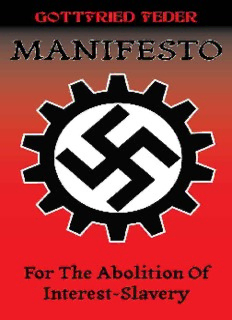
Manifesto for the Abolition of Enslavement to Interest on Money by Gottfried Feder PDF
Preview Manifesto for the Abolition of Enslavement to Interest on Money by Gottfried Feder
The Manifesto for the Abolition of Enslavement to Interest on Money with explanations provided by Gottfried Feder, Dipl. Engineer 1 9 1 9 Originally Published by Joseph C. Hubers Verlag, Diessen vor Muenchen, Germany Translated into English by Hadding Scott, 2012 New Translation Published 2012 by McHenry History © 2012 All Rights Reserved. Publisher’s Introduction Volumes of books have been written on the 3rd Reich and the Second World War that deal primarily with Adolf Hitler, his generals, the War, or other “exciting” tangents from the European Theater in that period of time. However I doubt that the families of the millions of men and boys who died in that tragedy known as WWII would refer to any of it as “exciting,” and this publisher would be in agreement with them. What is often left out of these books are the core principles and foundations of National-Socialism (Nazism) that got Hitler elected and brought Germany out of the depression before any other affected nation had. Adolf Hitler’s economic system – heavily influenced by the genius of Gottfried Feder – was unlike anything the world had ever seen, and it worked better than anyone predicted at the time. National-Socialist economics were of pivotal importance to Hitler’s government, but those policies are sadly very poorly understood today for a variety of reasons, including the aforementioned lack of “excitement” surrounding economic policies of 70+ years ago on the other side of the world. As the reader will soon come to understand, “breaking the bondage of interest- slavery” was strongly emphasized, though most Americans have never considered the idea of life without interest on a house or car payment. Gottfried Feder discusses this in his Manifesto, and almost all of what he says in it applies today as it did in 1919. Some authors and Nazi sympathizers have even suggested that if Germany’s brilliant economic ideas had spread to other nations, this would soon lead to the end of endless profits and power for the banksters, and hence the need for the Allied powers to bring Germany to her knees. Germany’s currency and trade systems begin to give one an understanding of the causes of World War II. This was stated by Hasting W. S. Russell, who wrote at the beginning of the War: “A war of financiers and fools, though most people, on the allied side at any rate, do not yet see very clearly how financiers come into it. . . . Financiers also desired war as a means of overthrowing their rivals and consolidating still further their immense power. . . . Hitler not only engaged in barter trade which meant no discount profits for bankers arranging bills of Exchange, but he even went so far as to declare that a country’s real wealth consisted in its ability to produce goods; nor, when men and material were available, would he ever allow lack of money to be an obstacle in the way of any project which he considered to be in his country’s interests. This was rank heresy in the eyes of the financiers of Britain and America, a heresy which, if allowed to spread, would blow the gaff on the whole financial racket.” Gottfried Feder (an early mentor of Hitler) had been advocating banking reform as early at 1917, and was ardently against interest slavery and usury. In his Manifesto he stated that the source of the banker’s power and wealth comes not from work, but from “the effortless and infinite multiplication of wealth which is created by interest.” Instead, the German State offered loans for a set price. For example, marriage loans up to 1000 marks were implemented and were repayable in interest free installments. A quarter of the loan was forgiven at the birth of each child. Via this method, people were never stuck paying off an interest charge each month like they are today with the credit card scam, but instead their payment actually went towards paying off their initial debt. Adolf Hitler describes the National Socialist monetary system in a succinct paragraph: “If ever need makes humans see clearly, it has made the German people do so. Under the compulsion of this need we have learned in the first place to take full account of the most essential capital of a nation, namely, its capacity to work. All thoughts of a gold reserves and foreign exchange fade before the industry and efficiency of well-planned national productive resources. We can smile today at an age when economists were seriously of the opinion that the value of currency was determined by the reserves of gold and foreign exchange lying in the vaults of the national banks and, above all, was guaranteed by them. Instead of that we have learned to realize that the value of a currency lies in a nation’s power of production, that an increasing volume of production sustains a currency, and could possibly raise its value, whereas a decreasing production must, sooner or later, lead to a compulsory devaluation.” He added, “We were not foolish enough to try to make a currency [backed by] gold of which we had none, but for every mark that was issued we required the equivalent of a mark’s worth of work done or goods produced.” The National- Socialist economy is one based off work and production. The twenty-five point “Program of the NSDAP” reflected the teachings of the influential Feder. Among these points are: “10. It must be the duty of every citizen to work either mentally or physically. The activities of the individual may not conflict with the interests of the general public but must be carried on within the framework of the whole and for the good of
Description: